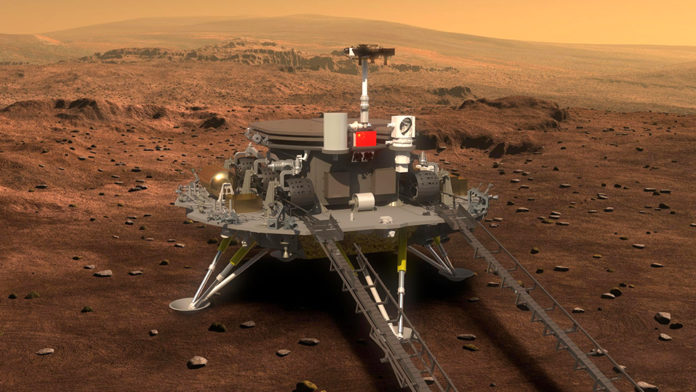BEIJING, May 15, 2021 (BSS/PTI) – China on Saturday successfully landed a spacecraft on Mars after surviving “nine minutes of terror”, becoming the second country in history to have a rover on the red planet.
The rover, Zhurong, named after a god of fire in Chinese mythology, successfully landed at the pre-selected area in Utopia Planitia on Mars, the official Xinhua news agency reported on the Communist giant’s latest achievement in its ambitious goals in space.
The six-wheel solar-powered Zhurong rover weighs about 240 kilogrammes and carries six scientific instruments. It will be later deployed from the lander for a three-month mission in search of life on Mars’ surface. Tianwen-1, consisting of an orbiter, a lander and a rover, was launched on July 23, 2020. It was the first step in China’s planetary exploration of the solar system, with the aim of completing orbiting, landing and roving on the red planet in one mission.
The China National Space Administration (CNSA) said in a statement that its rover has successfully landed on Mars on Saturday after “nine minutes of terror”.
The lander, carrying a Mars rover, touched down at its pre-selected landing area in the southern part of Utopia Planitia, a vast plain on the northern hemisphere of Mars, at 7:18 a.m. (Beijing Time), the CNSA said. It took ground controllers more than an hour to establish the success of the pre-programmed landing.
They had to wait for the rover to autonomously unfold its solar panels and antenna to send the signals after landing, and there was a time delay of more than 17 minutes due to the 320-million-km distance between the Earth and Mars. “The Mars landing of the Tianwen-1 mission has been a total success,” Zhang Kejian, head of the CNSA announced.
Zhang Rongqiao, chief designer of China’s first Mars exploration mission, said that the landing had been a textbook case of accuracy.
More than 40 Mars missions have been launched since the 1960s, but only about half have succeeded. The success rate for landing is even lower. The successful touchdown of the Chinese spacecraft on Mars is a remarkable achievement, given the difficult nature of the task.
Only the Americans have really mastered landing on Mars until now. All other countries that have tried have either crashed or lost contact soon after reaching the surface of the Mars.
Thomas Zurbuchen, Associate Administrator for the Science Mission Directorate at NASA was quick to congratulate China. “Congratulations to CNSA’s #Tianwen1 team for the successful landing of China’s first Mars exploration rover, #Zhurong!
“Together with the global science community, I look forward to the important contributions this mission will make to humanity’s understanding of the Red Planet,” Zurbuchen tweeted.
Significantly, it will now be a space race on Mars as the Chinese spacecraft has landed three months after the successful landing of US space agency NASA’s Perseverance rover which is busy exploring the red planet’s surface with a helicopter hovering around.
Previously the US, Russia, the European Union and India have succeeded in sending a spacecraft to Mars, regarded as the most complex space mission.
President Xi Jinping has congratulated the space scientists on the successful landing of China’s first probe on Mars. Xi said in the message that the landing marks an important step in China’s interstellar exploration and a leap from the exploration of the Earth-Moon system to interplanetary exploration.
“The landing left a Chinese mark on Mars for the first time. It is another landmark progress in China’s space industry development,” said Xi. “Thanks to your courage in face of challenges and pursuit of excellence, China is now among the leading countries in planetary exploration,” Xi said.
“The country and people will always remember your outstanding achievements,” he said. The Perseverance and Zhurong explore different parts of Mars. While the Perseverance landed in a deep crater near the planet’s equator called Jezero, the Zhurong rover would target Utopia Planitia, a vast terrain in the planet’s northern hemisphere. China’s mission to Mars followed successful missions to Moon, including landing a rover.
Last month China has put into orbit a core module as part of its effort to build a space station of its own to rival the ageing International Space Station (ISS). The Chinese spacecraft entered the Mars orbit in February after a journey of nearly seven months through space.
Onboard Zhurong, six types of scientific payloads are designed to unlock more secrets of the red planet. A sample-return mission is also planned, a Xinhua report said.
The spacecraft’s plummet through the Martian atmosphere, lasting about nine minutes, was extremely complicated with no ground control, and had to be performed by the spacecraft autonomously, Geng Yan, an official at the Lunar Exploration and Space Programme Center of the CNSA said.
“Each step had only one chance, and the actions were closely linked. If there had been any flaw, the landing would have failed,” said Geng.
A Xinhua commentary on the Mars mission said China is not looking to compete for leadership in space. Mars is at the forefront of international deep space exploration. It could help humanity go deeper into space and provide first-hand data for research, such as the origin and evolution of the solar system and life, it said.
Chinese scientists are looking for more evidence of water-ice, and will share the data with their international counterparts, it said.
China’s ambitious space programme triggered headlines last weekend when an out-of-control rocket plunged into the Indian Ocean near the Maldives — prompting a rebuke from NASA for failing to “meet responsibility standards regarding (its) space debris.”
The powerful Long March 5B rocket had launched part of China’s new space station into orbit in late April and had been left to hurtle through space uncontrolled until Earth’s gravity pulled it back in.



